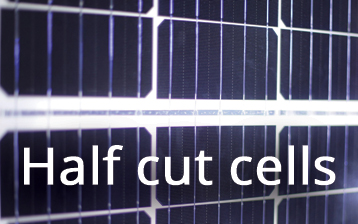Since 2017, a new technology that is growing in importance on the market is the so-called “half cut cells”, and it is often combine with the PERC technology.
In this way, it is possible to switch from the current standard modules with 60 or 72 6-inch cells, to 120 or 144 half-cells.
The transition to this new technology allows the increase of the power of the single module and of the producibility, thanks to the following factors.
A) Greater tolerance to shading
In traditional modules, cells are connected in series in a 6 x 10 matrix and the effect of a possible shadow is mitigated by the 3 bypass diodes.
In the event that a cell is not radiated like the others, one of the 3 diodes is activated and the module production is only guaranteed for 2/3 (a 300W module could roduce 200W).
On the left, the half-cut module on the right, the traditional module
Considering instead a module with 120 half-cut cells, there will be 2 series of 60 cells in parallel having in common the 3 by-pass diodes.
In this way, if a cell is shaded only 1/6 of the module will be affected by the shadow (a 300W module could therefore produce 250W).
B) Decrease in resistive losses
In half cut cells, since the surface is half compared to the whole cells, the current produced will also be halved and consequently the losses will be reduced by 1⁄4 (being the proportional losses to the square of the current).
Moreover, with a lower current circulating in the bus bars, the temperature of the module will be lower, thus contributing to increase its producibility.
C) Lower crack possibilities
In a cell with a smaller surface, microcracks formed over time will have less effect and the photovoltaic module will maintain its performance for longer.
If this technological innovation is supplemented by having cells with a high number of 5/6 or 12 bus bars (called multiwire) the benefits described in points B and C are amplified.
Market share estimated at 35% in 2020
With half cut cell modules, the power increases from 5 to 15W per module (depending on the type of cell). The market share of this technology is estimated to reach 35% in 2020







